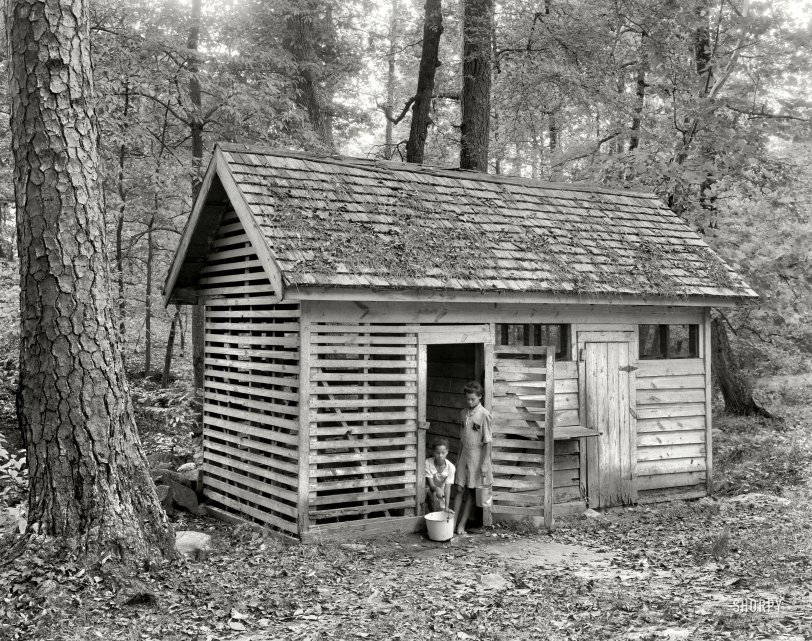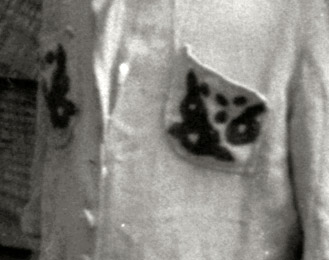


Framed or unframed, desk size to sofa size, printed by us in Arizona and Alabama since 2007. Explore now.
Shorpy is funded by you. Patreon contributors get an ad-free experience.
Learn more.

- Tough Guys
- Lost in Toyland
- And without gloves
- If I were a blindfolded time traveler
- Smoke Consumer Also Cooks
- Oh that stove!
- Possibly still there?
- What?!?
- $100 Reward
- Freeze Frame
- Texas Flyer wanted
- Just a Year Too Soon
- WWII -- Replacing men with women at the railroad crossing.
- Yes, Icing
- You kids drive me nuts!
- NOT An Easy Job
- I wonder
- Just add window boxes
- Icing Platform?
- Indiana Harbor Belt abides
- Freezing haze
- Corrections (for those who care)
- C&NW at Nelson
- Fallen Flags
- A dangerous job made worse
- Water Stop
- Passenger trains have right of way over freights?
- Coal
- Never ceases to amaze me.
- Still chuggin' (in model form)
Print Emporium
The Spring House: 1944

Wilkes County, Georgia, circa 1944. "Spring house, Hill Plantation. Washington vicinity." 8x10 inch safety negative by Frances Benjamin Johnston for the Carnegie Survey of the Architecture of the South. View full size.
I recognize the spring house!!
The picture above is indeed a spring house on the Old Hill Place Plantation. We own it now!! Bought it from the original owners several years ago. The right side of the spring house was for refrigeration and the left side houses the spring head. It bubbles all the time! Right now I am researching the two little girls in the photo. I think I may be able to find out who they are! Thanks for finding this picture. Dave, are there any more of Frances' photos around of the Old Hill Place or Wilkes County?
[Amazing! It sounds like a magical place. There are more photos here. - Dave]
Good news!
I am pleased to report that the structure in the photo is still standing, in much the same condition as in the picture. It is in fact a spring house, located at our home in Wilkes County, Georgia. The left side contains an artesian well, and this section empties into the right side. The right side contains a long, narrow trough filled with water. The trough is deeper at one end than the other. People would put jugs in the water, and items in the jugs (e.g., butter, milk) to keep them cool. Live, fresh fish were someimes kept in it until they were ready to be eaten. The right side empties into a stream in a forest.
Local lore has it that the water has mystical properties. I can't say for sure, but I can attest to the fact that the water is cool, clear, delicious, and abundant. Our house is probably located where it is because of this natural spring.
We think we might know the women in the photo, and we're checking with them.
My hometown
Great find! I grew up in Washington, Georgia, and am restoring an old house here now. I am pretty familiar with the many old homes and plantations we have there, but never heard of the Hill Plantation.
Lots of history here. Somewhat of a living time capsule, even today!
The Well and I
When I was little, my mother bought a farmhouse -- Ontario fieldstone, about 100 years old, then. We never actually moved in due to family circumstances so my mother rented it out and we would visit. The first visit we made, the well still hadn't been capped and a pump installed. They were drawing with a bucket from a hole in the floor of the well-house.
I was just toddling, at that point and when my mother took her eye off me for a second, I made a beeline for the well-house. They little boy of the family caught me by the straps of my sundress just as I tipped over the edge of the well.
A drowned chicken!
My first year of marriage, we lived on an oyster farm, near Quilcene, Washington, along with my in-laws. Our water came from a spring, which originated up on a hill, and we had a spring house much like the one in this picture. One day, I went out to the spring house and was shocked to find that a chicken had fallen into the water and drowned, with its wings out and a horrifying look on its face. I walked down to the house with my heart pounding, and into my in-laws' house, looking like I had seen a ghost. My mother-in-law was very alarmed and asked me what was wrong. When I told her that there was a drowned chicken in the spring house, she said, "Oh, is that all" and went and fished out the dead chicken. They had it for dinner that night. I had a piece of toast for dinner.
In W Va
My grandfather had an artesian well tapped into the side of the mountain that shot a good 20 feet horizontally before seeming to arc down. It fed a raspberry patch, a spring house, two large ponds and, finally, a creek with its overflow. My grandparents used the spring house to keep milk, eggs and butter cool before lugging them to the bottom of the hill to sell once a week. Part of the water was plumbed to the house (coldest showers I've EVER taken!) and then down the hill to the Ingole household in exchange for helping to tap the well to start with. The well was old when I was not even 10, and I'm nearly 60 now.
Washington memories
While traveling a few years ago I hopped off a Greyhound bus in Washington, GA. Later that night I ate dinner with the Mayor! It was a pretty small place.
Lively Dialogue
Girl on left: "Do you know Art?"
Girl on right: "Art who?"
Girl on left: "Art Tesian"
Girl on right: "Oh sure, I know Artesian well!"
Springhouse memories
I grew up next to my grandmother's house in South Carolina. In my time (and my father's) the house had indoor plumbing, but behind her house was a wellhouse featuring the classic round brick shaft sunk into the ground with a bucket and pulley mounted above on a crossbar. Down a gentle slope about 30 yards and into the woods was the foundations of a springhouse.
My father remembered when it was standing, a smallish low-ceiling building with stone walls. Inside was a pipe coming out of the ground that trickled water into a basin that in turn flowed out of the structure through another pipe, the water flowing down to a small pond. There were built-in shelves inside and cross timbers with movable hooks to hang items. He recalled it was still used for long-term storage of foods like cured hams, but had been mostly superseded by a refrigerator and icebox up at the house.
The well water was quite drinkable; by my day the well house had gone dry due to disuse and lack of maintenance, but Father remembered hauling up buckets of water for himself and his friends to drink when they didn't want to bother going inside.
The house I grew up in was supplied with water from a well my father had sunk when he built our house; all you had to do is treat it to remove excessive iron (it turned china and clothes yellow) and it was ready to drink, bathe with, etc.
No half moon
I'm just glad to see no half moon cut out of that door on the right!
Cool storage in lieu of refrigeration seems to be the consensus.
Not Washington.
Sorry but that tree on the left is a long leaf pine tree and it's straw is on top of the spring House. Long leaf pine didn't grow in Washington state or Washington DC then or now. Most are in North Carolina and it is an endangered species.
[If only people would read the captions we put under the photos! The Washington in question is Washington, Georgia. - Dave]
Bubbling Up
There was a good article on springs in the NY Times about a month ago.
Slats
My guess, and the only spring house I've seen were in south Texas where water is important (if not rare) and heat plentiful, is that the enclosed part houses the well (closed to keep animals out as Ginny said). The part with the slatted sides, where the girl's are sitting, was probably the wash house, and the slats were there to allow a breeze to keep those working cool.
Ventilation
Is the half-open part on the left the spring enclosure and the open-at-the-top part on the right cool storage?
What an awesome use of natural resources.
Around my place we have to drill deep into the ground for water.
I see bunnies
That adjacent room looks slightly more secure. So, I think maybe a place to keep produce that you wanted to keep cool. Love the cute little dress she's wearing with the velvet (?) bunnies on the pockets.

Chillin in the Spring House
I've been more than a few spring houses, and never saw one used as a drinking water supply. The ones I've seen housed a pool of cold spring water that was used to keep food from spoiling.
A Rural Privilege
Some comments make me realize how lucky I am to live in an area of the country where the occasional spring house still survives. For those not so lucky, I suppose the concept of clean, cold and potable water bubbling out of the ground is inconceivable.
Half the story
The spring house only seems to take up the left side of the structure. Could the right, screened-in side be a chicken coop or, perhaps, just a shed for yard equipment?
[You would probably not want chickens (and their byproducts) right next to your water supply, or food. - Dave]
The old springhouse
The title of this post and the caption are two definite clues that this might be a spring house! As you might infer from the name, a spring house houses a spring or well. The shed keeps animals and birds out. The bigger ones, at least.
Young girls
Beautiful girls in a gorgeous picture. Makes me wonder what that shack was used for.
[Something tells me it might be a spring house. - Dave]
























On Shorpy:
Today’s Top 5